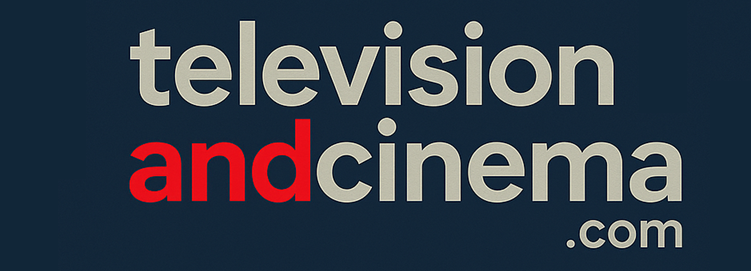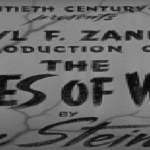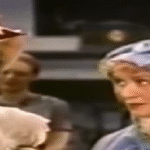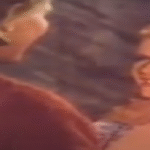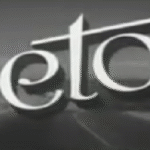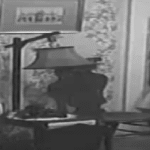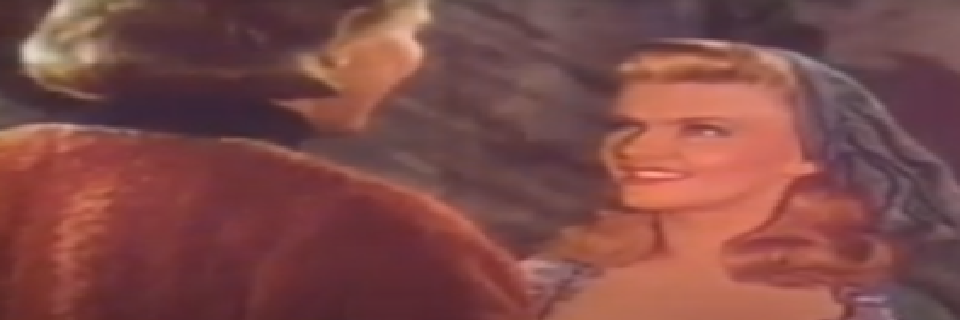Jack and the Beanstalk, released in 1952, is a colourful and charming retelling of the classic fairy tale, presented through the unique lens of the beloved American comedy duo Abbott and Costello. Directed by Jean Yarbrough, the film merges elements of traditional children’s storytelling with the slapstick humour and vaudevillian timing that made Bud Abbott and Lou Costello famous. It’s a light-hearted, fantastical romp that blends real-world framing with a dreamlike narrative, resulting in a whimsical experience designed to entertain both children and adults.
The film opens in a contemporary setting, shot in black and white. Lou Costello plays Jack Strong, a well-meaning but bumbling man searching for work. His friend and minder, Mr Dinkle, played by Bud Abbott, accompanies him as they arrive at a house looking for employment. There, they meet a kindly mother who offers Jack a job babysitting her young son Donald while she attends an event. Donald is particularly fond of fairy tales, and his favourite is the story of Jack and the Beanstalk. The little boy insists that Jack read the story to him, and though reluctant at first, Jack soon gives in. As he begins to read, the film transitions from monochrome into vibrant colour, signalling the shift into the magical world of the fairy tale.
This device of starting in black and white and switching to colour when the fantasy begins cleverly distinguishes the two worlds, much like in The Wizard of Oz. The fantasy portion of the film represents a dream Jack has while reading the story aloud, with many of the people from the real world reappearing in different roles. Jack himself becomes the titular character in the fairy tale, and Mr Dinkle transforms into the peddler who trades Jack’s cow for the infamous magic beans.
In this dream world, Jack lives in a small cottage with his overbearing mother and their cow, which has stopped producing milk. Desperate for money, his mother sends Jack to market to sell the animal. On his way, Jack encounters the eccentric Mr Dinklepuss, who convinces him to trade the cow for a handful of supposedly magical beans. When Jack returns home, his mother is furious and throws the beans out the window. Naturally, overnight, a massive beanstalk grows into the sky, reaching into the clouds and beckoning Jack to climb it.
This ascent leads Jack and Dinklepuss to a magical kingdom in the sky, ruled by a fearsome giant who has stolen a harp that brings happiness and song to the land. The giant, portrayed with a mix of menace and comedy, lives in a castle guarded by henchmen and is in possession of riches, a golden goose and a captive princess. The princess, played by Shaye Cogan, has also been spirited away from the lower realm, and Jack is determined to rescue her, defeat the giant and bring joy back to his world.
The castle sequences form the heart of the film, full of slapstick mishaps, miscommunication and narrow escapes. Costello’s Jack is both courageous and hopelessly clumsy, regularly endangering the rescue mission through his well-intentioned blunders. Abbott’s Dinklepuss, meanwhile, serves as the straight man, constantly frustrated by Jack’s antics but just as entangled in the chaos. Together, they bicker and stumble their way through the halls of the castle, evading guards, hiding in closets and devising hare-brained schemes to outwit the giant.
The humour throughout the film is classic Abbott and Costello — physical comedy, fast-paced banter, mistaken identities and wordplay. Though the film is squarely aimed at a family audience, it maintains a mischievous energy that keeps it from becoming overly saccharine. Much of its charm lies in the duo’s undeniable chemistry. Costello’s childlike naivety and wide-eyed expressions are perfectly balanced by Abbott’s dry delivery and exasperated sighs. Their comedic dynamic remains intact even within this fantasy setting, and their familiarity lends warmth to the story.
Despite the light tone, the film remains faithful to the basic beats of the original fairy tale. Jack eventually finds the harp and the golden goose, manages to free the princess, and flees the castle with Dinklepuss in tow. They descend the beanstalk just in time, with the enraged giant following behind. In a climactic moment, Jack chops down the beanstalk with an axe, causing the giant to fall and disappear. The kingdom is saved, and harmony is restored.
As Jack basks in his triumph, the film transitions back to the real world. Jack wakes up in the boy’s bedroom, the fairy tale finished and the adventure at an end. The fantasy has had a transformative effect on him, and in a final comedic twist, elements from the dream appear to cross over into reality, blurring the boundary between the two worlds. This ambiguous ending suggests that Jack’s experiences, though imagined, have left a lasting impression, reinforcing the timeless message that courage, imagination and a little bit of luck can lead to great things.
From a visual standpoint, the film is notable for its use of Cinecolor, a cheaper alternative to Technicolor that nonetheless provides a vibrant palette during the fantasy sequences. The contrast between the black-and-white real world and the colourful dreamscape enhances the film’s magical quality and underscores the divide between the mundane and the marvellous. The sets, costumes and props are simple but effective, evoking a storybook aesthetic that suits the light-hearted nature of the production.
Though not a blockbuster by today’s standards, Jack and the Beanstalk holds a special place in the world of family cinema. It captures the innocence of early fairy tale adaptations while showcasing the unique talents of one of comedy’s most enduring partnerships. It is very much a product of its time, with a tone and style reflective of post-war optimism and the early days of American television. Yet it also has an enduring appeal, drawing on a universally beloved story and delivering it with affection and humour.
The film’s blend of slapstick, song and storybook fantasy makes it more than just a vehicle for Abbott and Costello’s comedy. It is a heartfelt attempt to bring a cherished tale to life through the lens of two performers whose connection with audiences was built on laughter and warmth. At its core, Jack and the Beanstalk is about belief — in magic, in friendship and in the possibility of something better just beyond the clouds. Whether taken as a simple fairy tale or a nostalgic piece of cinematic history, it remains a delightful journey up the beanstalk and into the realm of dreams.
